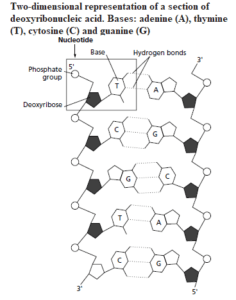Biosynthesis of Nucleotides
Nucleotides are composed of a cyclic nitrogenous base, a pentose sugar (ribose or deoxyribose) and phosphate. The base may be a purine, either adenine or guanine, or one of three pyrimidines, cytosine, thymine or uracil.
These nucleotides are the building blocks of deoxyribonucleic acid (DNA) and ribonucleic acid (RNA). They are also important constituents of several coenzymes, and have key roles in the activation and transfer of sugars, amino acids and cell wall components.
Most microorganisms can synthesize their own purines and pyrimidines. Purine synthesis is complex, the purine skeleton being derived from several components, whereas pyrimidines originate from orotic acid, a product of the condensation of carbamoyl phosphate with aspartic acid.
Ribose 5-phosphate is generated in the PP pathway and is used here in the activated form of phosphoribosyl pyrophosphate (PRPP). It condenses with the base precursor orotic acid to form pyrimidines.
In purine biosynthesis, the compounds are built up by several additions of fragments to the PRPP molecule. Deoxyribose forms of the nucleosides are then generated by reduction of the sugar moiety of ribonucleosides.
The nucleosides are finally phosphorylated to form nucleotide triphosphates by successive phosphorylation from ATP, in order that they can participate in further metabolic processes.
Biosynthesis of Nucleic acids
There are two types of nucleic acid, DNA and RNA, and both are composed of nucleotide building blocks. The two nucleic acids differ in the sugar found in their nucleotides, either deoxyribose or ribose.
Both polymers are made by the formation of covalent bonds between the sugar and phosphate groups of adjacent nucleotides. This sugar–phosphate backbone is common to all nucleic acid molecules. The unique nature of nucleic acid molecules resides in the sequence of bases.
Four bases can occur in each nucleic acid. Three bases, adenine, guanine and cytosine, are common to both RNA and DNA, but thymine of DNA is replaced by uracil in RNA. The various forms of RNA, which play key roles in protein synthesis, include messenger (mRNA), ribosomal (rRNA) and transfer (tRNA).
DNA is double stranded, composed of two helical chains each coiled around the same axis. Both chains follow right-handed helices, with the two chains running in opposite directions. Bases of each strand are on the inside of the helix with the phosphates on the outside.

A key feature of the structure is the manner in which the two chains are held together by the purine and pyrimidine bases. A single base from one chain is hydrogen bonded to a single base from the other chain, so that the two lie side by side.
One of the pair must be a purine and the other a pyrimidine, and only specific pairs of bases can bond together. These base pairs are: adenine (purine) with thymine (pyrimidine) and guanine (purine) with cytosine (pyrimidine). Hence, the two strands of DNA have a complementary sequence of bases.
Reference and Sources
- https://www.exploratorium.edu/origins/coldspring/printit.html
- https://en.wikipedia.org/wiki/Metabolism
- https://www.sciencedirect.com/topics/engineering/krebs-cycle
- https://www.genome.gov/about-genomics/fact-sheets/Deoxyribonucleic-Acid-Fact-Sheet


1 thought on “Biosynthesis of Nucleotides and Nucleic acids”
Very good notes very helpful